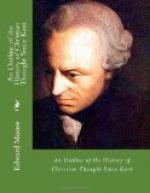BAUR
Baur, Strauss’ own teacher in Tuebingen, afterward famous as biblical critic and church-historian, said of Strauss’ book, that through it was revealed in startling fashion to that generation of scholars, how little real knowledge they had of the problem which the Gospels present. To Baur it was clear that if advance was to be made beyond Strauss’ negative results, the criticism of the gospel history must wait upon an adequate criticism of the documents which are our sources for that history. Strauss’ failure had brought home to the minds of men the fact that there were certain preliminary studies which must needs be taken up. Meantime the other work must wait. As one surveys the literature of the next thirty years this fact stands out. Many apologetic lives of Jesus had to be written in reply to Strauss. But they are almost completely negligible. No constructive work was done in this field until nearly a generation had passed.
Since all history, said Baur, before it reaches us must pass through the medium of a narrator, our first question as to the gospel history is not, what objective reality can be accorded to the narrative itself. There is a previous question. This concerns the relation of the narrative to the narrator. It might be very difficult for us to make up our minds as to what it was that, in a given case, the witness saw. We have not material for such a judgment. We have probably much evidence, up and down his writings, as to what sort of man the witness was, in what manner he would be likely to see anything and with what personal equation he would relate that which he saw. Baur would seem to have been the first vigorously and consistently to apply this principle to the gospel narratives. Before we can penetrate deeply into the meaning of an author we must know, if we may, his purpose in writing. Every author belongs to the time in which he lives. The greater the importance of his subject for the parties and struggles of his day, the safer is the assumption that both he and his work will bear the impress of these struggles. He will represent the interests of one or another of the parties. His work will have a tendency of some kind. This was one of Baur’s oft-used words—the tendency of a writer and of his work. We must ascertain that tendency. The explanation of many things both in the form and substance of a writing




